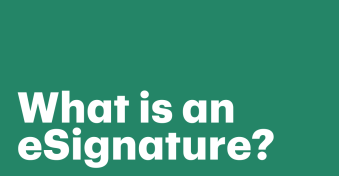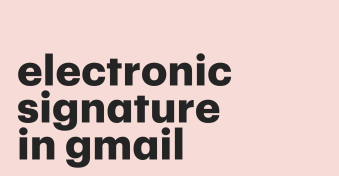Authentication and security are essential components to digital signature capture.
Sensitive data needs to be secure to establish confidentiality during the transaction.
Signers need to be authenticated to ensure nonrepudiation in the event of a dispute.
Not all companies place a major emphasis on these aspects of the document signing process, but it’s a particular emphasis for both DocuSign and OneSpan Sign.
In this article, we’ll take a closer look at how these two software solutions compare to one another.
Let’s get started.
Key takeaways
- DocuSign offers a top-notch user experience and features a diverse and functional toolkit.
- OneSpan Sign is the e-signature arm of OneSpan, a company focused around identity validation and data security.
- Both companies provide a user workflow that will fit comfortably into most business processes.
OneSpan Sign (formerly eSignLive)
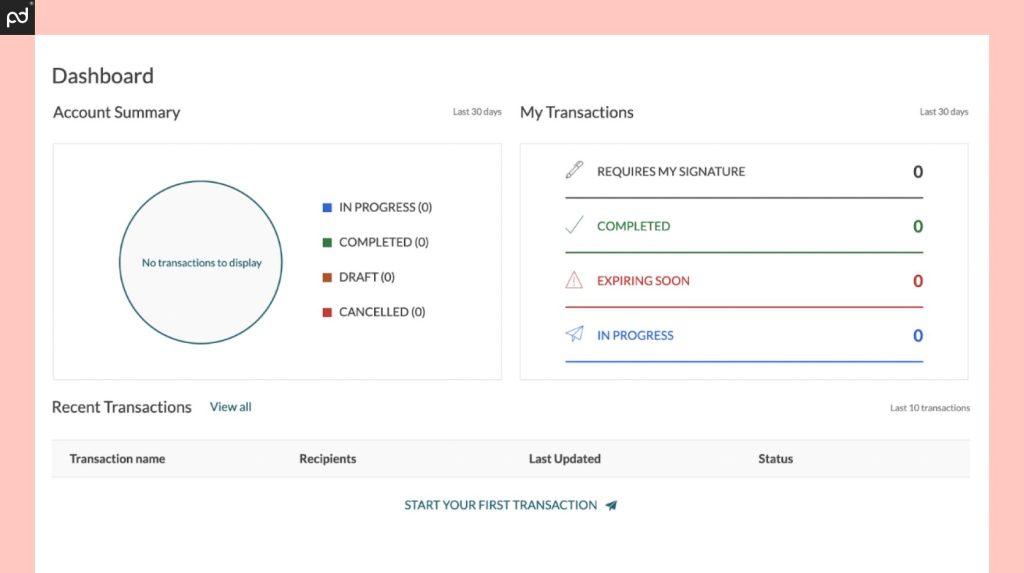
Pricing: Professional Plan ($22).
Pricing based on month-to-month commitment. Enterprise solutions available.
Ease of use: 8.5/10
Free trial: Yes; 30 days.
Support: Knowledge base; support tickets; phone support.
OneSpan Sign is a unique entry into the e-signature field because of its specialized focus on document security and user authentication.
While most other digital signature solutions — including PandaDoc — offer standard security solutions through industry compliance (SOC Type 2, GDPR, eIDAS, etc.), OneSpan Sign emphasizes its commitment to security and enhanced compliance as its major selling point.
In many ways, this makes sense.
This e-signature software platform is part of OneSpan, which aims to be a market leader in identity verification and authentication.
Separate from e-signing, the organization offers strong biometric and anti-fraud solutions for enterprise clients, with a particular emphasis in the financial services, insurance, and banking sectors.
Depending on your use case and security needs, working hand-in-hand with a company that makes security and authenticity a central component of their business model might make OneSpan Sign the best solution on the market.
DocuSign
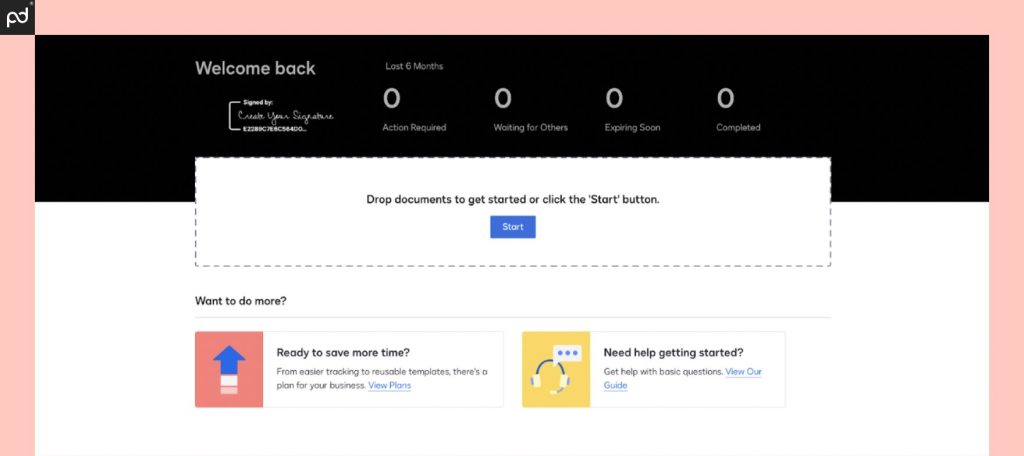
Pricing: Personal ($15); Standard ($45); Business Pro ($60).
Enterprise pricing available. All pricing based on month-to-month commitment.
Ease of use: 9.0/10
Free trial: Yes; 30 days.
Support: Knowledge base; support tickets; additional support plans sold as separate packages.
A global leader in e-signing tools, DocuSign is no slouch when it comes to document security and authentication.
However, it’s not their primary focus.
Instead, DocuSign places a greater emphasis on fast, seamless, and user-friendly signing solutions that save time, money, and headaches.
The company puts up some strong numbers to this effect, as well, touting 400+ pre-built integrations, 99.9% uptime, and packaged solutions that scale well with small businesses, specialized teams, and enterprise-level organizations.
As one of the biggest e-signing solutions around, DocuSign excels in most industries and geographies due to its compliance, ease of use, and narrow focus on e-signing as a separate-but-essential part of the document management process.
OneSpan Sign vs DocuSign at a glance
Ready to see how OneSpan Sign and DocuSign compare to one another?
Here’s a closer look at the top-tier plans offered by both companies.
| Plan Details | DocuSign | OneSpan Sign |
|---|---|---|
| Plan Name | Standard | Professional |
| Core product | ||
| E-signature capture | ✓ | ✓ |
| Real-time audit trail | ✓ | ✓ |
| Notifications | ✓ | ✓ |
| Language support | ✓ | ✓ |
| Mobile app | ✓ | ✓ |
| Reporting tools | ✓ | ✓ |
| E-signing features | ||
| Signing order | ✓ | ✓ |
| Send to multiple recipients | ✓ | ✓ |
| Bulk send | X | $ |
| In-person signing | ✓ | ✓ |
| Collaboration tools | ✓ | X |
| Signer attachments | X | ✓ |
| Payment gateway | X | X |
| Document prep | ||
| Drag & drop fields (PDF) | ✓ | ✓ |
| Create reusable templates | ✓ | ✓ |
| From-scratch document builder | X | X |
| Pre-built template library | X | X |
| Form creation | X | X |
| Custom branding | ✓ | ✓ |
| Integrations & API | ||
| Import & storage | ✓ | Limited |
| CRM | X | $ |
| Productivity | ✓ | Limited |
| API | $ | Enterprise only ($) |
| Support | ||
| Email / ticketing support | ✓ | ✓ |
| Chat support | X | X |
| Knowledge base | ✓ | ✓ |
| Phone | X | ✓ |
| Premium support options | $ | Enterprise only ($) |
In the interest of fairness and pricing, we’ve compared OneSpan Sign to DocuSign’s mid-range plan (Standard) in the chart above.
Keep in mind while comparing that DocuSign offers a more expensive plan (Business Pro), which is available at a considerable expense.
On a monthly contract, Standard is roughly double the cost of OneSpan Sign’s Professional Plan, but the annual commitment lowers the cost to $25/month, which creates a more realistic comparison.
One final aspect to consider are transaction limits.
- DocuSign limits users to 100 envelopes per user/year.
- OneSpan Sign limits users to 1000 transactions per user/year.
Roughly speaking, envelopes and transactions are the same.
Anytime you initiate an e-signature request, you’ll consume an envelope/transaction to send your document (or documents, if you send a bundle) to your intended group of recipients.
DocuSign counts envelopes even if documents are never signed, so staying mindful of the transaction limit is essential to avoid account overages and additional/unintended fees.
OneSpan Sign offers 10x the number of transactions compared to DocuSign.
It’s a small but critical detail for users who need to send a high volume of documents as part of their regular workload.
Requirements, workflows & pricing
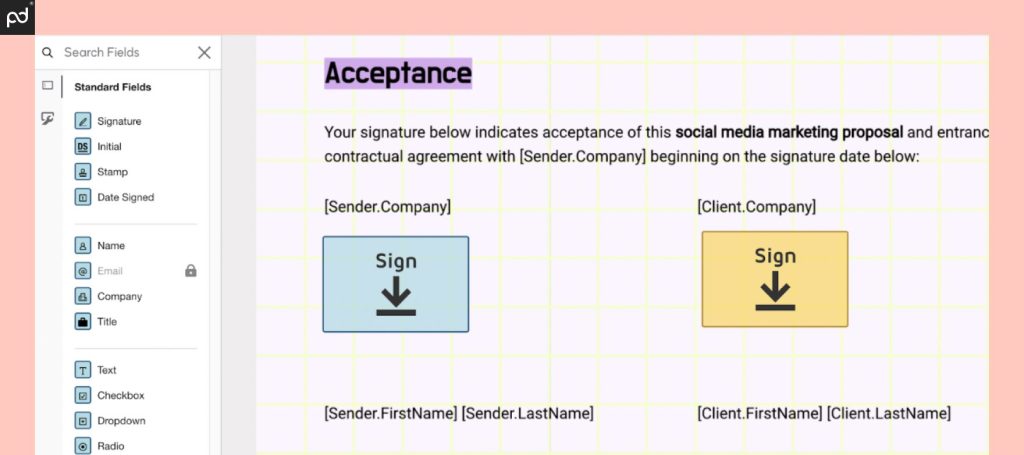
As an electronic signature solution, both DocuSign and OneSpan Sign occupy a similar position in the document workflow.
Using either tool will require you create a contract, proposal, or similar document using Microsoft Word, Google Docs, or another word processor.
Neither e-signing platform can facilitate true, from-scratch document creation like PandaDoc; it has to be handled elsewhere.
Once you have your completed document, you’ll need to upload it to the signing tool either directly or through a storage integration (Box for OneSpan Sign; DocuSign offers several options).
From there, you’ll use the onboard, drag-and-drop formatting tools to prepare your document for e-signing.
Both DocuSign and OneSpan Sign offer a user-friendly interface, so the experience is largely the same between them.
That’s important, considering the similarity in price between the DocuSign’s Standard and OneSpan Sign’s Professional Plan options.
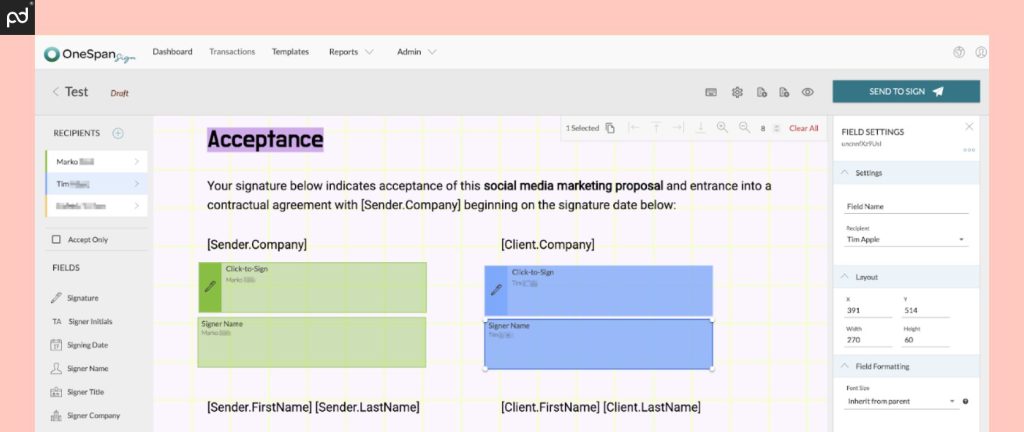
The greatest differences between each platform come down to the additional features included in each plan.
For example, DocuSign offers collaboration and commenting tools, as well as expanded integration options that you simply won’t see in OneSpan Sign.
Users seeking the ability to connect to specific software solutions are more likely to find those connectors in DocuSign’s arsenal.
Curiously, OneSpan Sign has an advantage in this realm due to DocuSign’s own restrictions.
DocuSign users can’t access the most popular CRM platforms (Salesforce, Workday, etc.) without an Enhanced (enterprise) plan while OneSpan Sign users can connect on the Professional Plan.
OneSpan Sign also features white-labeling — that is, the ability to completely remove any OneSpan branding from web pages and emails that signers see.
The company bills this as a security and phishing protection feature.
While DocuSign offers brand customization options, white-labeling is completely off the table.
Customers will always know that they’re using the DocuSign platform.
There is no way to hide or obscure this in emails and correspondence.
Our suggestion
It’s important to keep in mind that both DocuSign and OneSpan Sign offer all the standard tools you’ll need for a complete e-signing experience.
The real difference in terms of workflow will come down to the integration and collaboration features offered in both tools and how you plan to utilize them.
- DocuSign is ideal if partner integrations and collaborative tools are tools you intend to use. Moving up to the Business Pro plan also unlocks payment gateways and form creation tools that OneSpan Sign doesn’t have.
- OneSpan Sign is a great way to gain access to premium integrations that DocuSign only offers on its enterprise plan. Plus, the annual transaction limit is 10x higher than what DocuSign offers.
PandaDoc offers true from-scratch document creation and a solid collection of native integrations. It’s a great alternative for users who want to edit, e-sign, and manage documents in one place.
Security & authentication
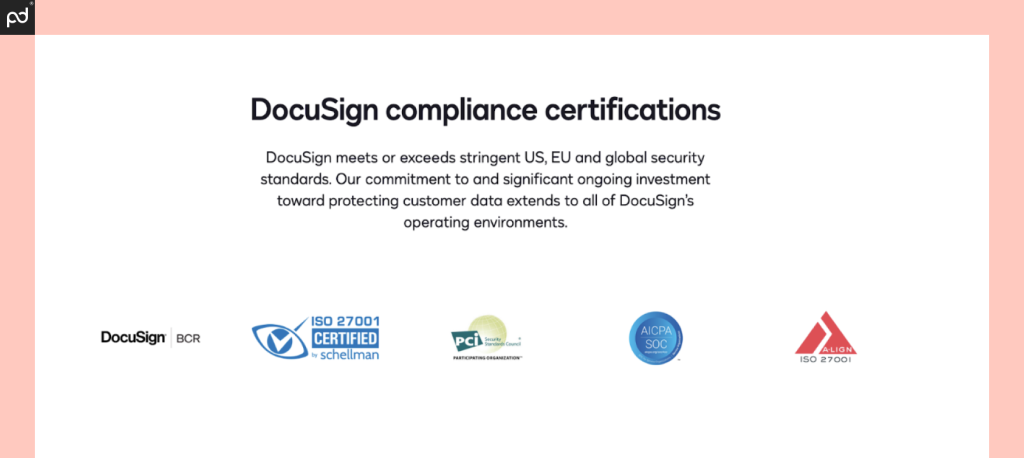
No matter which e-sign platform you choose, security functionality is essential to ensure the validity and authenticity of your signed documents.
Both DocuSign and OneSpan Sign offer robust security measures to protect sensitive documents and transactions.
However, there are some critical differences in their approaches to security.
DocuSign has long been an industry leader in e-signatures, and its security credentials are well-established.
The platform employs a range of features like encryption, audit trails, user permissions, and tamper-evident seals to ensure the integrity and authenticity of signed documents.
The company also complies with various international standards like SOC 2 and ISO 27001 (just like PandaDoc), demonstrating its commitment to data protection.
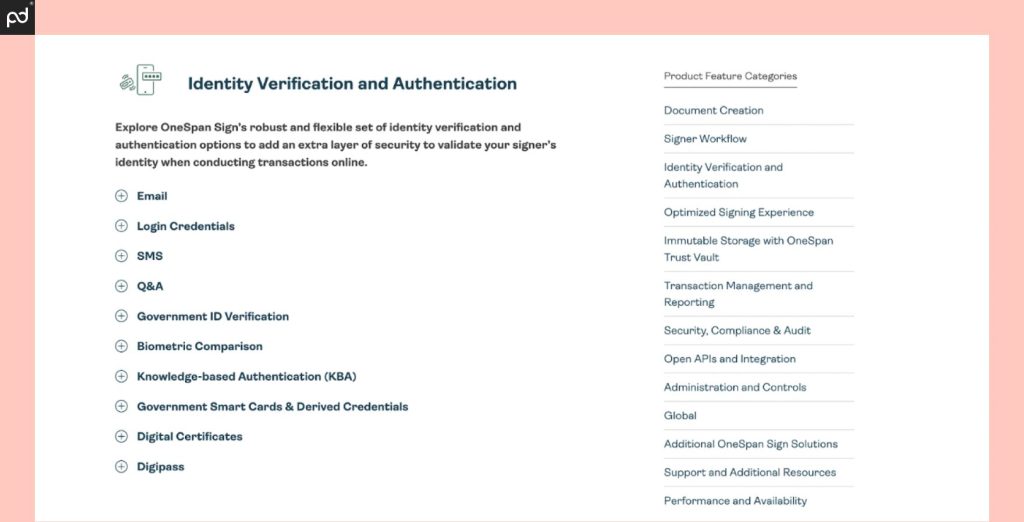
By comparison, OneSpan Sign places an even stronger emphasis on security due to the company’s core business focus on digital security solutions.
As a result, OneSpan Sign provides a wider array of identity verification and authentication methods than DocuSign.
These include options around knowledge-based authentication (KBA), which ask signers to answer personal questions to verify their identities.
OneSpan Sign also supports advanced authentication methods like biometrics and government-issued digital IDs.
This security-first mindset makes OneSpan Sign a compelling option for heavily regulated industries like finance and healthcare where heightened identity verification is crucial.
Their granular controls enable businesses to implement multi-factor authentication, ensuring the signer is truly who they claim to be, further reducing the potential for fraud or unauthorized access.
However, despite OneSpan Sign’s edge in identity verification, DocuSign’s extensive security measures should not be underestimated.
Both companies have many overlapping security features (like verification with SMS), and DocuSign is widely recognized and trusted in the industry, offering reliable security for countless businesses of all sizes.
For many organizations, DocuSign’s security features will be more than sufficient and the ease of use may make it a more appealing choice.
Our suggestion
Ultimately, the “better” e-signature solution depends on your specific needs and priorities.
While the general consensus might be that “more security is better,” that’s not necessarily true above a certain threshold.
If you operate in an industry with strict security and compliance requirements, the advanced authentication options of OneSpan Sign can provide an extra layer of protection for your sensitive transactions.
On the other hand, if you prioritize simplicity and streamlined workflows, DocuSign’s robust security features, along with its widespread adoption and ease of use, would be a solid choice.
- DocuSign, PandaDoc, and most other e-signing platforms provide legally binding e-signatures with audit trails and security signing methods that ensures their validity.
- OneSpan Sign offers additional security features that will be ideal (but not always required) for key industries and business sectors.
Branding & white labeling
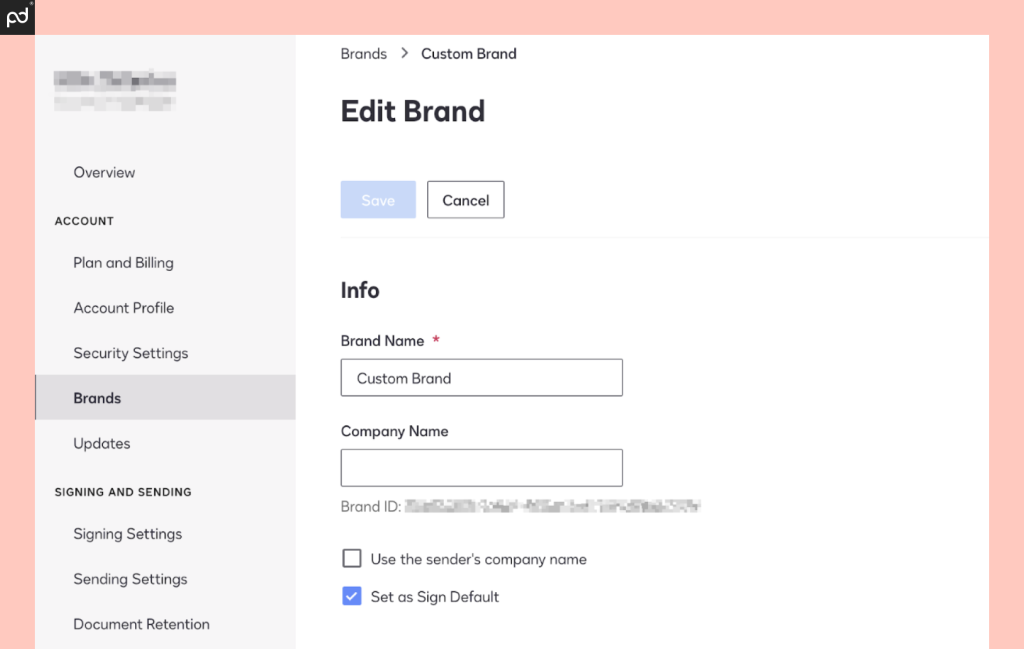
Ensuring a consistent brand experience for your customers is important when using e-signing platforms because you’re essentially handing your customer off to a third party solution.
Fortunately, both DocuSign and OneSpan Sign (like many other e-signing platforms) have recognized this and made the transition much easier by offering brand customization features.
However, there are a few key differences to consider.
Both platforms allow you to tailor the look and feel of your e-signature process by incorporating your company logo and adjusting color schemes to match your brand identity.
These features help maintain a seamless user experience and reinforce brand recognition and are a common feature for most platforms.
DocuSign takes a unique approach to this by allowing users to create and manage multiple brands.
While this feature is only available at the enterprise level, it’s beneficial for larger organizations or those with multiple divisions, allowing them to dynamically switch between different brand styles during the signing process.
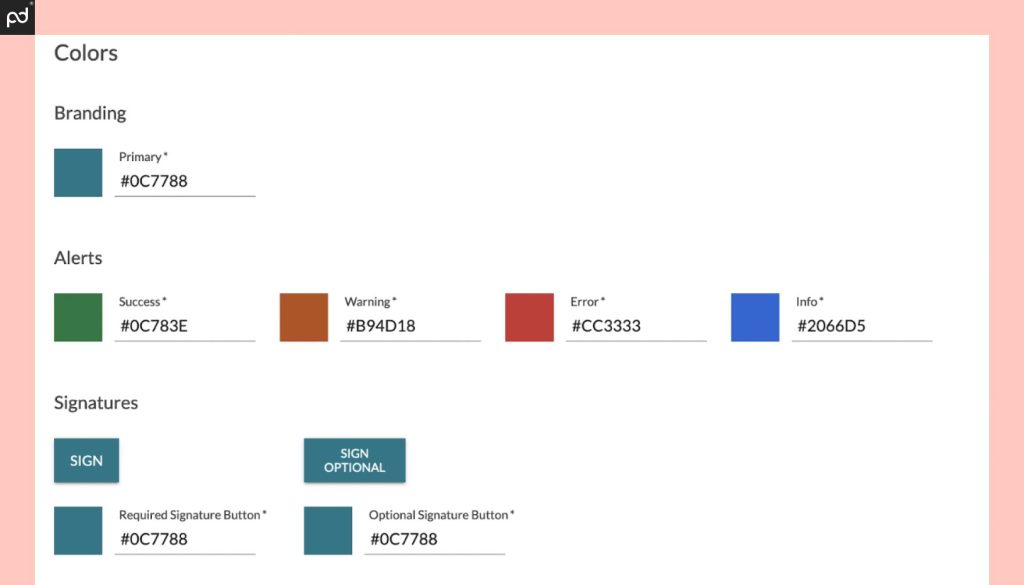
By contrast, OneSpan Sign takes branding a step further with its white-labeling option.
White labeling allows you to completely replace the OneSpan Sign branding with your own.
This means your customers will interact solely with your brand throughout the entire signing process, from the initial email invitation to the final signed document.
It’s something very unique in the industry.
The vast majority of e-signing platforms provide some branding options, but white labeling is offered or considered.
OneSpan Sign touts this as a security feature, explaining that, by taking this approach, you’ll be able to increase security by concealing the vendor you use for e-signing.
While that may be true, the level of customization alone is particularly valuable in scenarios where fostering trust and brand confidence is essential.
Our suggestion
The ideal branding solution comes down to your specific needs.
If complete control over the customer’s visual experience is critical for building trust, OneSpan Sign’s white-labeling capability is a clear advantage.
But, if that’s not the case, the standard toolkit offered by DocuSign and others may be more than enough to suit your needs.
- DocuSign offers standardized branding options that will work for most users. If you need to manage multiple brands from one account, you’ll need an Enhanced Plan.
- OneSpan Sign’s white-labeling features have some notable benefits around security and customer experience, but these are superficial adjustments (at a certain point) and don’t provide any key benefits beyond signer perception.
Customer support
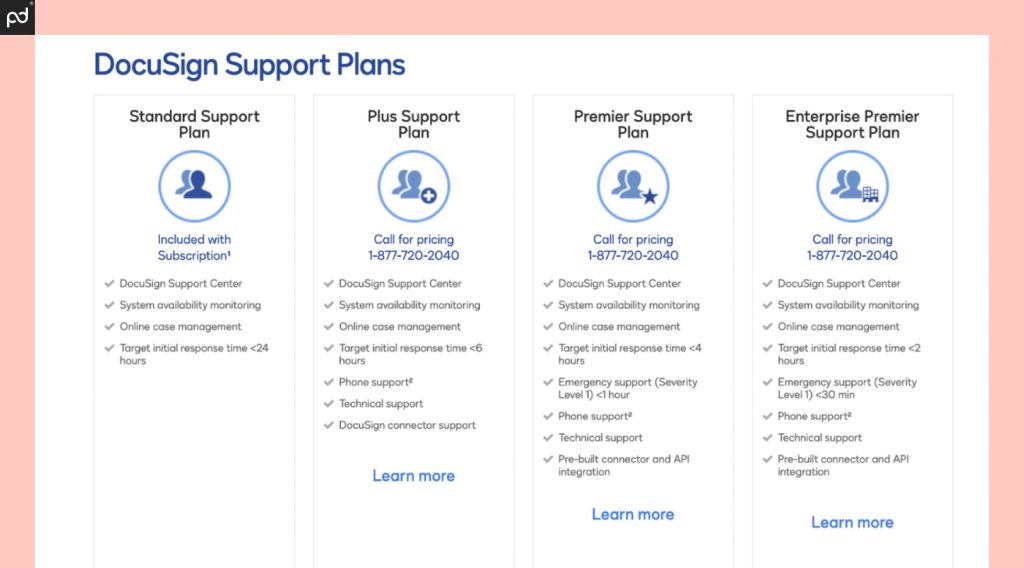
Creating a great support experience is an essential aspect of any e-signing operation.
Most companies in the space have self-serve options, like a knowledge base, FAQ section, or a help center, but the real questions surrounding support come down to the ease of access during critical periods.
With that in mind, both DocuSign and OneSpan Sign each approach customer support with slightly different philosophies.
DocuSign offers a tiered support structure.
Their standard plans generally rely on online resources like the aforementioned knowledge bases, community forums, and email/ticket-based support.
DocuSign targets a 24-hour response time on standard support inquiries, which may suffice for many users.
For businesses that need more immediate, personalized support, DocuSign offers premium support plans for an additional cost.
These plans provide benefits like faster response times, phone support, and often, dedicated account managers.
The plans are worth considering for enterprise organizations with mission-critical e-signature workflows that require guaranteed rapid assistance.
However, for smaller businesses who don’t want to pay extra support fees, these plans may be out of reach.
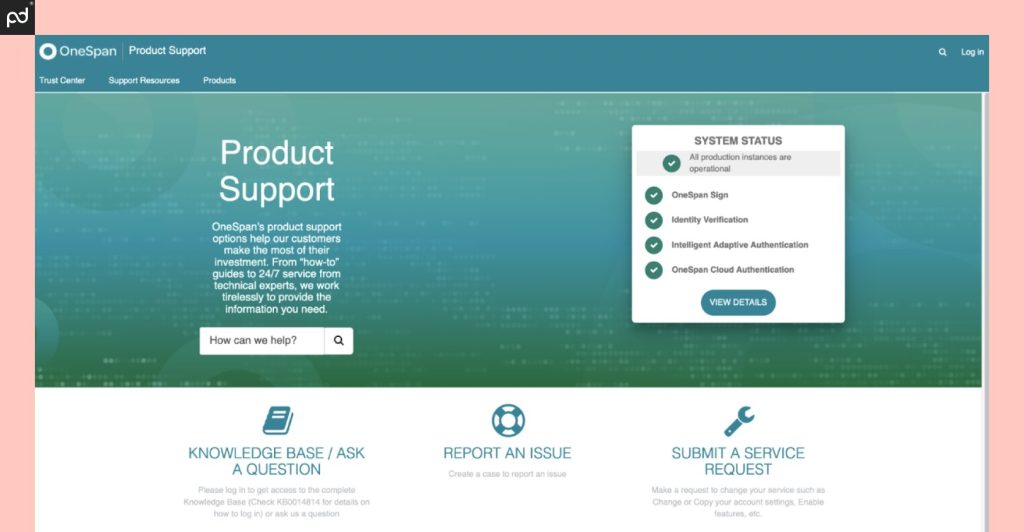
By contrast, OneSpan Sign prioritizes direct access. Their support model includes phone support for a more hands-on approach.
This can be especially appealing for businesses that require swift troubleshooting or have complex technical questions.
The company also provides extensive online resources (training videos, documentation, developer community, etc.) for self-server support during non-business hours.
This combination of direct access and self-service tools offers customers diverse ways to resolve their issues.
Our suggestion
At PandaDoc, we offer chat support for all plans and premium support options for users who need or prefer a more hands-on approach.
We’ve found that, no matter how great the documentation and knowledgebase, sometimes, people need help.
With that in mind, we always appreciate when other brands provide live support options as part of their standard package.
While we understand DocuSign’s paid tiers, the targeted 24-hour waiting period for standard plans can be a notable pain point when technical issues prevent a deal from moving forward.
- DocuSign’s Standard support plan is lackluster, but its paid plans may be very appealing to enterprise-level teams.
- OneSpan Sign offers phone support for its plans, so direct access is always available. No premium support plans are available.
- PandaDoc offers chat support and premium support options, so you’ll always have access to the help and can take advantage of specialized services if they make sense for your business.
Alternatives to OneSpan Sign & DocuSign
As you probably know, OneSpan Sign and DocuSign aren’t the only e-signing tools on the market today.
In the same way that OneSpan Sign brings a unique offering to the table (compared to the industry standards set forth by DocuSign), many other companies offer their own spin on e-signing.
Here’s a quick list:
- PandaDoc
- DocHub
- Adobe Acrobat Sign (formerly Adobe Sign)
- SignNow
- SignRequest
Not sure where to start? We’d recommend giving PandaDoc a try.
We offer a complete, from-scratch document editor as part of our core product.
PandaDoc users can consolidate their entire document workflow — from creation to e-signature and storage — in one place.
If you’d still prefer to work in Microsoft Word or Google Docs, we’ve got integrations for that, too!
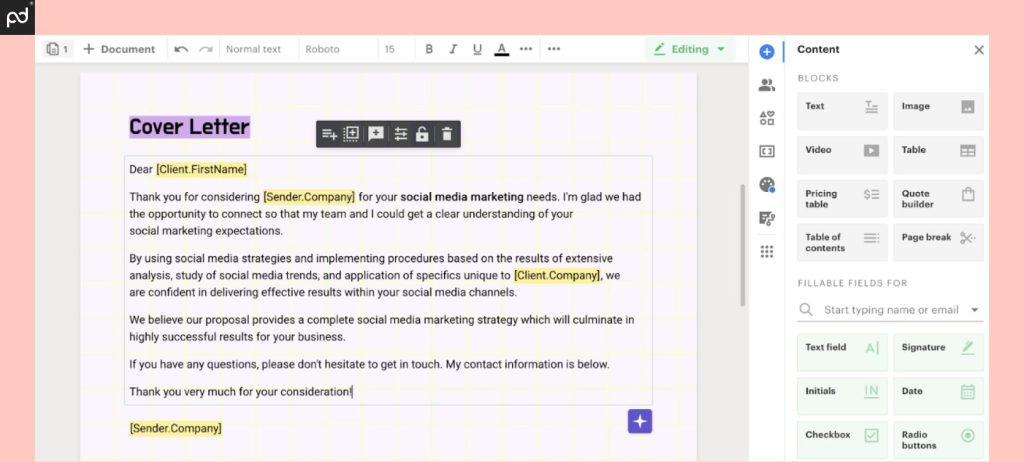
Build better documents with PandaDoc
Without a doubt, DocuSign and OneSpan Sign are strong competitors in the e-signing space.
Both platforms will be a great fit for the right user but, if you’re considering other options, don’t forget about PandaDoc.
Our end-to-end document workflow makes it easy to keep track of documents and consolidate everything in one place. (People rave about it in the user reviews all the time.)
In addition to our document editor and e-signature tools, you’ll find 1000+ templates to help you get started, a content library for even faster document creation, and chat support.
Plus, we have native apps for iOS and Android, so you can take your documents on the go anytime, anywhere.
Get a free demo see how PandaDoc can simplify your entire document workflow.
Disclaimer
Parties other than PandaDoc may provide products, services, recommendations, or views on PandaDoc’s site (“Third Party Materials”). PandaDoc is not responsible for examining or evaluating such Third Party Materials and does not provide any warranties relating to the Third Party Materials.
Originally published May 12, 2022, updated May 9, 2024
